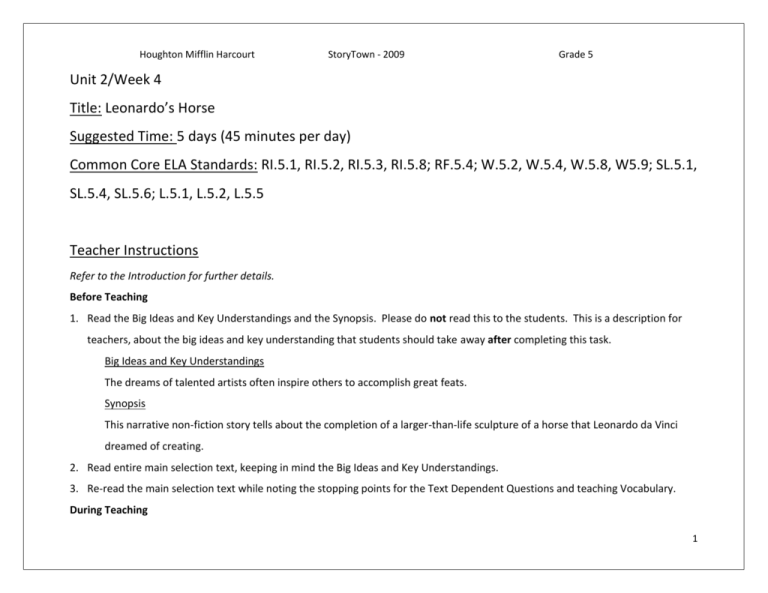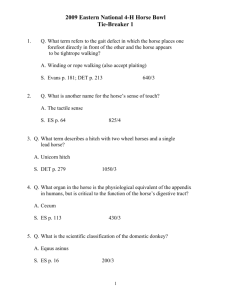Unit 1/Week 1
advertisement

Houghton Mifflin Harcourt StoryTown - 2009 Grade 5 Unit 2/Week 4 Title: Leonardo’s Horse Suggested Time: 5 days (45 minutes per day) Common Core ELA Standards: RI.5.1, RI.5.2, RI.5.3, RI.5.8; RF.5.4; W.5.2, W.5.4, W.5.8, W5.9; SL.5.1, SL.5.4, SL.5.6; L.5.1, L.5.2, L.5.5 Teacher Instructions Refer to the Introduction for further details. Before Teaching 1. Read the Big Ideas and Key Understandings and the Synopsis. Please do not read this to the students. This is a description for teachers, about the big ideas and key understanding that students should take away after completing this task. Big Ideas and Key Understandings The dreams of talented artists often inspire others to accomplish great feats. Synopsis This narrative non-fiction story tells about the completion of a larger-than-life sculpture of a horse that Leonardo da Vinci dreamed of creating. 2. Read entire main selection text, keeping in mind the Big Ideas and Key Understandings. 3. Re-read the main selection text while noting the stopping points for the Text Dependent Questions and teaching Vocabulary. During Teaching 1 Houghton Mifflin Harcourt StoryTown - 2009 Grade 5 1. Students read the entire main selection text independently. 2. Teacher reads the main selection text aloud with students following along. (Depending on how complex the text is and the amount of support needed by students, the teacher may choose to reverse the order of steps 1 and 2.) 3. Students and teacher re-read the text while stopping to respond to and discuss the questions and returning to the text. A variety of methods can be used to structure the reading and discussion (e.g., whole class discussion, think-pair-share, independent written response, group work, etc.) Text Dependent Questions Text Dependent Questions Reread the introduction on page 231. Who was Leonardo? What were his accomplishments? What important project remained unfinished at the time of his death? According to the author, how were Leonardo da Vinci and Charles Dent similar? Why did Dent decide to create the horse? (pg. 232) Look at the illustration on page 233. How does it help you understand what a dome-shaped building looks like and why it was necessary? (pg. 233) Why did Charles Dent borrow horses? (pg. 233) Answers Leonardo da Vinci is a famous painter. He created some of the most famous paintings in the world. He was also known as a musician, an engineer, an architect, an astronomer, and a philosopher. The project that remained unfinished at the time of his death was a larger than life sculpture of a horse. They both loved art. They were both dreamers with big dreams. Leonardo longed to fly and Charles was an airline pilot. Charles Dent was an art lover and that made him care about Leonardo; so when he read that Leonard died still upset about his unfinished project, he felt compelled to see the sculpture done. The picture shows the shape of the building. It also shows how small real horses were compared to the size horse he wanted to make. The size he wanted was much too large to fit into a regular barn. Charles Dent borrowed two horses, so he could study them and measure them. 2 Houghton Mifflin Harcourt StoryTown - 2009 Reread the first paragraph on page 234. Using specific quotes from the text, describe what Charles Dent’s first 8-foot model of the horse looked like. A gesture is an action that shows your feelings. What kind of gesture did Charles Dent plan to make on behalf of the American people? (pg. 234) Why was Charles Dent unable to see to the completion of the horse sculpture? (pg. 234) A foundry is a factory that produces metal castings. What happened to the 8ft tall clay model of the horse when it reached the Tallix Foundry in Beacon, New York? Was the horse as grand as Charles Dent envisioned ?(pg. 235) Who was Nina Akamu? Why did she have to ‘start from scratch’ on the horse? (pgs. 235-236) Reread the second paragraph on page 236, what does the author mean by, “as soon as Nina went to work, he had to become her horse, too”? Why did the statue have to be reassembled when it arrived in Italy? (pg. 240) Grade 5 The clay horse was 8 ft tall and made of clay. The horse’s left foreleg was raised and bent, his right rear leg was off the ground and free. The muscles in the hindquarters were tense; his ears pointed forward, his nostrils beginning to flare. The horse was to be a gesture of friendship from the American people to the Italian people, a salute across the centuries to Leonardo. It was to be sent to Milan, Italy. Charles Dent died in 1994 before the sculpture was finished. The transformation began at the foundry. The horse model was enlarged, cut up into sixty pieces and then put together. When the horse was put together, it was out of proportion. Nina Akamu is a talented sculptor out of New York, and she agreed to try and fix the problems. She was unable to fix the original model because the plaster on it resisted or wouldn’t change. Note to Teacher: You may have to explain what plaster is and why it couldn’t be molded in a different way once it was dry. The idea for the horse came from Charlie Dent, but Nina had to feel connected to the horse in a way too. She needed to become inspired, and she needed to feel like this was her project. The horse was too big to ship; so it had to be cut up into separate pieces, crated, and flown to Italy. When it arrived, the pieces were reassembled. 3 Houghton Mifflin Harcourt StoryTown - 2009 Grade 5 Whinnying is the sound horses make when they neigh. What does the author mean when she says the horse statue was “within whinnying distance” of the horses’ stable at Milan’s racetrack? (pg. 240) Not only would Leonardo’s horse statue be close to the stable where there are other horses, but it would be so close it would be able to hear them whinny. What did Nina Akamu do to the statue to honor Leonardo da Vinci, Charles Dent, and her? (pg. 241) Nina wrote Leonardo da Vinci and Charles Denton in tiny letters on the horse’s pupils. She wrote her name in the curly mane of the horse. Even though it was built in the United States, it belonged in Italy, where Leonardo da Vinci lived and started work on the original horse that sparked this project. Reread page 242. Why was Leonardo’s horse finally home? 4 Houghton Mifflin Harcourt StoryTown - 2009 Grade 5 Vocabulary STUDENTS FIGURE OUT THE MEANING sufficient context clues are provided in the text TEACHER PROVIDES DEFINITION not enough contextual clues provided in the text KEY WORDS ESSENTIAL TO UNDERSTANDING Words addressed with a question or task Page 234 - gesture Page 235 - foundry Page 240 - whinny WORDS WORTH KNOWING General teaching suggestions are provided in the Introduction Page 231 - sculpture Page 232 - grieve, scholar, specialize Page 234 - steady, hindquarters, flare, cast, salute Page 235 - envision, proportion Page 239 - embedded Page 232 - envious Page 233 - dome, miniature Page 235 - hoist, resist Page 238 - molten; shims Page 240 - pedestal Page 241 - cluster 5 Houghton Mifflin Harcourt StoryTown - 2009 Grade 5 Culminating Task Write a paragraph about how the dream of Leonardi da Vinci inspired Charles Dent. Cite evidence from the text, including specific quotes to support your ideas. Answer: Leonardo da Vinci, a famous artist that lived over 500 years ago, had a dream to sculpt a “larger-than-life sculpture of a horse” and died before his dream could be realized. This was almost forgotten until Charles Dent read about Leonardo’s horse in a magazine article in 1977. Charles Dent “loved art-reading about it, making it, looking at it, collecting it”, and he was inspired by da Vinci’s story. When Dent read that “Leonard died still grieving for his horse,” sculpting the horse became the “biggest dream of his life.” Charles Dent was so inspired by Leonardo da Vinci’s story that he spent the rest of his life dedicated to sculpting the horse and even had his own family promise to see the horse sculpture finished after Dent’s death. Additional Tasks Using the diagram and text on Page 238 provide a list of materials used to complete the process of creating the statue. Answer: Thin metal pieces called shims Clay Liquid rubber Plaster Sand and cement Bronze 6 Houghton Mifflin Harcourt StoryTown - 2009 Grade 5 More information and pictures related to this story can be found at http://www.davincisciencecenter.org/inside-dsc/leonardoand-the-horse/the-people-of-leonardos-horse/ This site has multiple links about Leonardo’s horse that could be used for short, small group research projects. Each group could research on one area of this story, from Leonardo da Vinci to the completion of the sculpture; create a slide presentation, and report out to the class. Note to Teacher According to HMH this story is at 810L, which is within the range for 5 th grade according to CCSS, Appendix A On page 241 the author states that September 10, 1999 is important not only because the horse statue was being unveiled, but also because 500 years earlier the French invaded Milan and destroyed Leonardo’s horse. This is confusing because the invasion and the original model is not explained in the story, only referred to on this page. Leonard da Vinci had completed the 24 ft tall clay model, but before it could be cast in Bronze, the French invaded Milan and destroyed it. Da Vinci did not restart the model and supposedly died grieving the loss. This information and more is available on the link from additional tasks. 7 Houghton Mifflin Harcourt StoryTown - 2009 Name __________________________________________ Grade 5 Date _________________ “Leonardo’s Horse” 1. Reread the introduction on page 231. Who was Leonardo? What were his accomplishments? What important project remained unfinished at the time of his death? 2. According to the author, how were Leonardo da Vinci and Charles Dent similar? Why did Dent decide to create the horse? (Pg. 232) 3. Look at the illustration on page 233. How does it help you understand what a dome-shaped building looks like and why it was necessary? (Pg. 233) 4. Why did Charles Dent borrow horses? (Pg. 233) 8 Houghton Mifflin Harcourt StoryTown - 2009 Grade 5 5. Reread the first paragraph on page 234. Using specific quotes from the text, describe what Charles Dent’s first 8-foot model of the horse looked like. 6. A gesture is an action that shows your feelings. What kind of gesture did Charles Dent plan to make on behalf of the American people? (Pg. 234) 7. Why was Charles Dent unable to see to the completion of the horse sculpture? (Pg. 234) 8. A foundry is a factory that produces metal castings. What happened to the 8ft tall clay model of the horse when it reached the Tallix Foundry in Beacon, New York? Was the horse as grand as Charles Dent envisioned? (Pg. 235) 9. Who was Nina Akamu? Why did she have to ‘start from scratch’ on the horse? (Pgs. 235236) 9 Houghton Mifflin Harcourt StoryTown - 2009 Grade 5 10. Reread the second paragraph on page 236, what does the author mean by, “as soon as Nina went to work, he had to become her horse, too”? 11. Why did the statue have to be reassembled when it arrived in Italy? (Pg. 240) 12. Whinnying is the sound horses make when they neigh. What does the author mean when she says the horse statue was “within whinnying distance” of the horses’ stable at Milan’s racetrack? (Pg. 240) 13. What did Nina Akamu do to the statue to honor Leonardo da Vinci, Charles Dent, and her? (Pg. 241) 14. Reread page 242. Why was Leonardo’s horse finally home? 10






